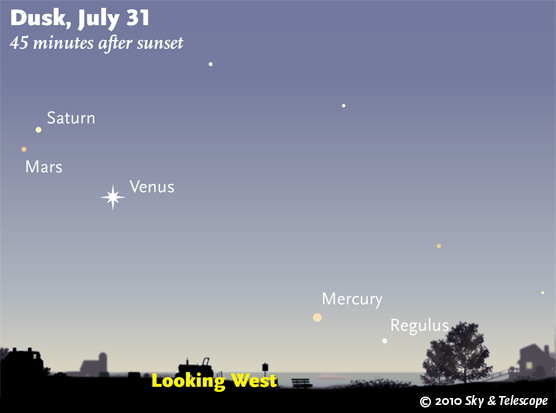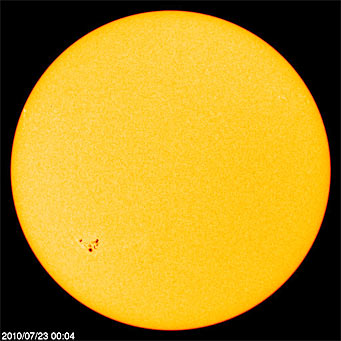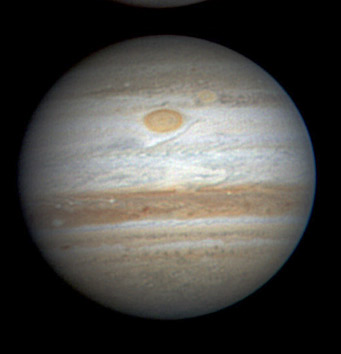
Four planets shine in the western twilight. One dazzles; the others appear tiny by comparison. Watch them changing positions day by day! This is their arrangement at week's end. (The visibility of faint objects in bright twilight is exaggerated here.)
Sky & Telescope diagram
Friday, July 23
Saturday, July 24
Sunday, July 25
Monday, July 26
Tuesday, July 27
Wednesday, July 28
Thursday, July 29
Friday, July 30
Saturday, July 31
Want to become a better amateur astronomer? Learn your way around the constellations. They're the key to locating everything fainter and deeper to hunt with binoculars or a telescope.
For an easy-to-use constellation guide covering the whole evening sky, use the big monthly map in the center of each issue of Sky & Telescope, the essential magazine of astronomy. Or download our free Getting Started in Astronomy booklet (which only has bimonthly maps).
Sky Atlas 2000.0 (the color Deluxe Edition is shown here) plots 81,312 stars to magnitude 8.5. That includes most of the stars that you can see in a good finderscope, and typically one or two stars that will fall within a 50× telescope's field of view wherever you point. About 2,700 deep-sky objects to hunt are plotted among the stars.
Alan MacRobert
Once you get a telescope, to put it to good use you must have a detailed, large-scale sky atlas (set of charts). The standards are the Pocket Sky Atlas, which shows stars to magnitude 7.6; the larger Sky Atlas 2000.0 (stars to magnitude 8.5); and the even larger and deeper Uranometria 2000.0 (stars to magnitude 9.75). And read how to use your charts effectively.
You'll also want a good deep-sky guidebook, such as Sky Atlas 2000.0 Companion by Strong and Sinnott, or the more detailed and descriptive Night Sky Observer's Guide by Kepple and Sanner, or the classic if dated Burnham's Celestial Handbook.
Can a computerized telescope take their place? I don't think so — not for beginners, anyway, and especially not on mounts that are less than top-quality mechanically. As Terence Dickinson and Alan Dyer say in their Backyard Astronomer's Guide, "A full appreciation of the universe cannot come without developing the skills to find things in the sky and understanding how the sky works. This knowledge comes only by spending time under the stars with star maps in hand."
This Week's Planet Roundup

The Sun displayed a triple spot when imaged by the SOHO spacecraft on July 23rd at 0:04 Universal Time.
SOHO / MDI
The Sun is becoming magnetically active again as it begins the upswing of its 11-year activity cycle. On Friday July 23rd, sharp-eyed observers could detect a triple spot through a solar filter without using a telescope. The active region, seen here in a monitoring image from the SOHO spacecraft, moved to the right (celestial westward) across the Sun's face in the next several days as the Sun rotated. By Sunday the 25th the trio had become a pair on the Sun's central meridian. On Monday the 26th I could not see them using the #14 arc-welder's filter I keep in my desk.
Check the group's progress at SOHO's near-real-time images of the Sun.
Mercury (magnitude 0.0) is low in the west after sunset this week. About a half hour after sundown, look for it near the horizon well to the lower right of brighter Venus. Fainter Regulus (magnitude +1.3) passes by Mercury this week; they're in conjunction on Tuesday the 27th. Binoculars will help.
Venus (magnitude –4.2, near the hind foot of Leo) is the bright Evening Star sinking in the west as twilight fades. In a telescope, Venus is now barely more than half lit. It becomes a crescent later this summer.
Mars (magnitude +1.5) is near Saturn to the upper left of bright Venus at dusk. Watch Mars close in on Saturn (which is slightly brighter) during the week. In a telescope Mars is just a tiny blob 4.8 arcseconds in diameter.

Jupiter's Great Red Spot and the smaller Oval BA ("Red Spot Junior") are drawing closer together and should pass each in the coming weeks or months. Oval BA is just to the Great Red Spot's upper right here. South is up.
Notice too that the dark South Equatorial Belt (just below the Great Red Spot) is starting to reappear, in a thin and irregular way, along with what may be part of the Red Spot Hollow. This image is one of a series that Christopher Go took on July 17th. Click for his animation of 10 images spanning 47 minutes as Jupiter rotated.
Jupiter (magnitude –2.6, in Pisces) rises around 10 or 11 p.m. daylight saving time. It shines high in the southeast in the early morning hours and is highest in the south by dawn. It's the brightest starlike point in the morning sky.
Jupiter's Great Red Spot is near System II longitude 150°. Assuming it stays there, here's a list to print out of all the Great Red Spot's predicted transit times for the rest of 2010.
Saturn (magnitude +1.1) is the slightly brighter of the two planets upper left of Venus in evening twilight. (The other is Mars.) Saturn, Mars, and Venus will bunch up in early August.
In a telescope Saturn's rings are still very narrow, just 3° from edge on, as Saturn shrinks into the distance on the far side of the Sun.
Uranus (magnitude 5.8, in Pisces) is 3° west of Jupiter. In a telescope Uranus is only 3.6 arcseconds wide, compared to Jupiter's 45″.
Neptune (magnitude 7.8, at the Aquarius-Capricornus border) is up in good view by midnight, well to Jupiter's west. See our finder charts for Uranus and Neptune in 2010.
Pluto (magnitude 14, in northwestern Sagittarius) is highest in the south in early evening. See our big Pluto finder charts in the July Sky & Telescope, page 60 — though moonlight compromises your chances for much of this week.
All descriptions that relate to your horizon or zenith — including the words up, down, right, and left — are written for the world's mid-northern latitudes. Descriptions that also depend on longitude (mainly Moon positions) are for North America. Eastern Daylight Time (EDT) equals Universal Time (also known as UT, UTC, or GMT) minus 4 hours.
To be sure to get the current Sky at a Glance, bookmark this URL:
http://SkyandTelescope.com/observing/ataglance?1=1
If pictures fail to load, refresh the page. If they still fail to load, change the 1 at the end of the URL to any other character and try again.
 0
0
Comments
You must be logged in to post a comment.